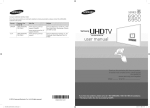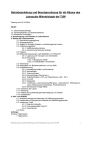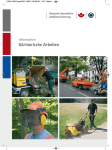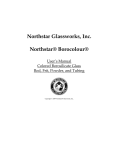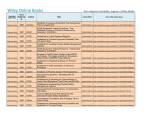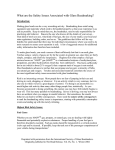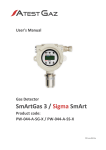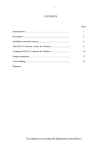Download OPERATING INSTRUCTIONS
Transcript
INSTITUTE OF ORGANIC AND BIOMOLECULAR CHEMISTRY AT THE UNIVERSITY OF GÖTTINGEN OPERATING INSTRUCTIONS According to § 20 GefStoffV These operating instructions serve to ensure safety and accident prevention in laboratory operations. They contain regulations that are binding for all persons working in laboratories. They do not release anyone of the responsibility of being careful at all times according to ones own knowledge, even when no specific instructions have been given. The following safety regulations must be followed in any case. General Laboratory Regulations All people working with gaseous, liquid or solid hazardous materials (including dust and waste) must observe special rules and specific safety requirements for conducting their work. Everyone is required to continuously inform himself regarding any changes in the rules. When dealing with materials where harmlessness is in doubt, one is to work with the materials as if they were hazardous. Absorption of harmful chemicals by the human body can occur via inhalation, through the skin, across mucous membranes and tbrough the digestive System. Thus, one should protect oneself from all forms of contamination! Therefore, eating, drinking and smoking are especially forbidden in the laboratory! Hazardous materials are chemicals or preparations that have one or more of the following characteristics: highly toxic (T+), toxic (T), dangerous to human health (Xn), corrosive (C), irritating(Xi), explosive (E), oxidizing (0), highly flammable (F+), very flammable (F), flammable, carcinogenic, dangerous to reproduction, mutagenic, sensitizing and dangerous to the environment (N), or other characteristics that cause chronic damage or those that create or liberate, by means of reactions or other uses, dangerous or explosive chemicals or preparations. They are labeled with the following symbols: E F F+ explosive very flammable highly flammable oxidizing toxic T+ U C Xn Xi highly toxic dangerous corrosive to the environment dangerous to human health irritating - O T (Danger symbols and names. Black on orange-ycllow background. [RAL 1004, 1006, or 1007].) Substances, preparations and products that can transmit disease-causing agents based on experience are also considered hazardous materials. All of the following regulations are to be abided by when working with hazardous materials: 1.0 Obligation of information 1.01 Before using any Hazardous Materials, the user is to determine the dangerous properties of the substances based on the safety data sheets, the list of dangerous substances and preparations according to §4a of the Hazardous Materials Ordinance (GefStoffV) and based upon the manufacturing and dealer catalogues and appropriate listings. The necessary documents can be found in the chemical storage room (Mr. Schrommek or Mr. Tucholla, Room 110a in the workshop building) or in the institute‘s library. Determination of ”special danger” (R-Sätze) and ”safety suggestions” (S-Sätze) are binding in any case and must be adhered to. 1.02 In order to fulfill the requirements of the Hazardous Materials Ordinance (GefStoffV), a hazardous materials listing must be logged in every laboratory. 1.03 The log must at least contain the following characteristics for the present hazardous materials: 1. Label (name of the substance, valid nomenclature) 2. Category i.e., dangerous characteristics 3. Maximum amount present according to weight or volume 1.04 The log must be updated in the case of considerable changes and should be reexamined at least once annually. Inclusion of new substances, alteration of category placement and changes in present amounts of more than 20% are considered to be considerable changes. 1.05 The hazardous material listing and the names and addresses including the private telephone numbers of the people working regularly in the respective laboratory should be placed in a transparent folder on or next to the laboratory door (on the hall side) in case of emergency. 1.06 Safety instructing must take place at least once annually in every work group. It is to be conducted by the group leader or by a safety expert designated by him/her. Those who participate in the instructing are to sign off for documentation purposes. 1.07 A safety folder must be made up for each work group containing at least the following documents: -Hazardous Materials Qrdinance (GefStoffV) with appendices -Lists according to §4a Hazardous Materials Ordinance (GefStoffV) -Regulations for laboratories (GUV 16.17) -Safe working in chemistry laboratories (GUV 50.04) -Accident prevention instructions First Aid (GUV 0.3) -Operating instructions according to §20 Hazardous Materials Ordinance (GefStoffV) -Special operating instructions according to §20 Hazardous Materials Ordinance -Fire prevention regulations of the University of Göttingen -Regulations for users of the institute for organic chemistry -Regulations for the use of compressed gas cylinders and autoclaves -Regulations for the disposal of hazardous waste -Safety data sheets for all hazardous materials in use -A list of the annual safety instruction participants with their signatures. 2.0 Basic rules: 2.01 Eating, drinking and smoking is prohibited without exception in the laboratory! Food and beverages must not be stored with chemicals. 2.02 Hazardous materials must not be stored in containers designed for food or in packaging which could be mistaken for food. 2.03 The presence of a second person within calling distance is required for all experimental work (prohibition to work alone in the laboratory). 2.04 Chemical experiments may only be left alone if continuous surveillance is not necessary or if a co-worker, who has been instructed in the Operation and safety devices, takes over the monitoring. 2.05 Hazardous materials not in break-proof containers must be transported in break-proof devices (buckets, carriers, etc.). 2.06 Highly toxic and toxic substances and preparations must always be in locked cabinets and should be stored such that only knowledgeable people have access to them. 2.07 Flammable liquids which have to be stored at cool temperatures as well as highly flammable and flammable substances must be stored in properly labeled explosion-proof refrigerators and freezers with interiors that have no ignition sources. 2.08 All containers containing chemicals should be properly labeled with substance names. All containers with hazardous materials must also be labeled with the proper danger symbols, large containers (>1 litre) must be completely labeled also with special danger and safety suggestions (R- and S-Sätze). Non-break-proof containers (volume >1 litre) containing flammable substances must be stored in safety cabinets and not in the laboratory. Waste containers must be labeled according to the technical rule for hazardous materials TRGS 201 ”Labeling of hazardous waste” (”Kennzeichnung beim Umgang mit Abfällen”). 2.09 All work with highly toxic, toxic, carcinogenic, dangerous to human reproduction and/or mutagenic substances must be conducted under the hood (digestorium) in closed glass or quartz apparatus. Inhalation of vapors and dust and contact with eyes and skin of these hazardous materials is to be avoided. Always work under the hood when it is necessary to have the hazardous material containers open (gaseous, liquid or solid substances and those having a high vapor pressure). However, closed apparatus should always be used when possible. 2.10 Safety goggles with side protection must always be worn in the laboratory rooms, Those wearing glasses must wear either optically corrected safety goggles or safety goggles according to W DIN 2 over their own glasses. If chemicals enter the eyes, the eyes should be washed immediately with copious amounts of fresh water. 2.11 Special safety goggles must be wom when working with high energy light sources (UV, Xenon lamps, lasers, etc.) to protect the eyes from being damaged by short-wave radiation or against high light intensity. (Spectral range according to DIN 4647, Pages 2-3 or the respective instructions from the manufacturer). In addition, the light sources must be sufficiently shielded. The same applies, for example, for work with oxygen blowpipe burners in the case of glassblowers. 2.12 All syntheses under excess pressure must be conducted (after special instruction) in autoclaves in the respective safety rooms or behind the appropriate protective walls (for details see GUV 16.17 number 3.7, 5.4.1 and 11.4 andNo. 38 TRB 801 ”Special pressurized containers based on appendix II to §12 DruckbehV” (”Besondere Druckbehälter nach Anhang II zu §12 DruckbehV”). 2.13 If the safety suggestions (S-Sätze) require personal protection such as safety goggles, face protection and appropriate gloves, etc., then these must be worn in any case. A gas mask with the appropriate filter should be ready at the work station when using highly toxic, toxic or corrosive gases or solvent vapors of highly toxic substances. 2.14 Appropriate work clothes should always be worn in the laboratory, for example, a sufficiently long lab coat with long sleeves with material that does not present a great danger in the case of fire. Street clothes are not considered appropriate working clothes. Qnly closed, sturdy and non-slippery footwear are to be worn in the laboratory. 2.15 Accidents occurring at work or on the way to work as well as injuries are to be reported immediately to Mrs. Peinemann in the secretary‘s office (Room P 3) at the latest, three days after occurrence. An ”accident report form” must be filled out there. Minor injuries should be entered in the injury register (Verbandsbuch) in Room P 3 (for documentation in case of possible following or delayed damage). 3.0 Basic protective and safety equipment 3.01 All people working in the laboratory must inform themselves about escape routes, location of fire extinguishers and how to operate them, emergency showers, eye washers and gas masks with their appropriate filters. When a fire extinguisher has been used, the caretakers (Hausmeister) or the safety supervisor must be notified immediately. Empty fire extinguishers or those with a damaged lead seal should be exchanged for functional ones immediately available from the caretakers (Hausmeister). 3.02 In addition, each person working in the laboratory must inform himself as to the location and mode of Operation of emergency shut-down devices for gas and electricity as well as for the water supply. If these are damaged in any way, the main switch/faucet should be closed and the caretakers (Hausmeister, Tel: 4133 or 302) should be notified immediately. Cutting off the gas, electricity or water supply should be limited to emergencies, and all others (coworkers) working with these should be warned at once. 3.03 The hoods should be constantly monitored as to their functionality, for example, using a strip of paper, piece of yam or a small propeller. A handle can be used to change the setting of the vent for sucking out light or heavy gases under the hood. The front window of the hood should always be kept closed! Please note that the laboratory‘s ventilation System can only work properly when the windows and doors to the laboratory are closed! Defective hoods are not allowed to be used! 3.04 The siphons in the floor drains, the sinks at the lab tables and under the hoods must always be filled with water in order to protect the workers from H2S odors from the drainage System water network. (H2S is highly toxic!) 4.0 Alarm systems and escape routes 4.01 The emergency alarm, fire alarm and emergency shut-down devices are for your safety. Abuse or negligent behaviour is punishable. 4.02 The fire department and emergency aid can be reached on number 112 from every telephone. 4.03 Fire alarms can be found in the main entrances and on every floor (and between the two elevators/lifts in the stairwells). They have a direct line to the fire station. When the fire alarm has been set off, a yodel/horn signal can be heard. The same signal can be heard when the automatic smoke alarms in the cable shaft and the heat sensors in the laboratories go off. When the yodel/horn signal is heard, one is immediately prepare to leave the institute as quickly as possible. The heaters of running experiments are to be turned off. The elevators/lifts must not be used in this case. 4.04 Emergency shut-off devices are near the doors of all laboratories. In the case of an emergency, electricity and gas for the experiments can be turned off for each laboratory. The electricity can be turned back on by turning the button to the right (the button pops back out). The gas can only be turned back on by pressing a red button on the median supply unit of the laboratory table. 4.05 In addition, there is a different button for the in-house emergency line installed in the laboratories. This button should only be pressed in the case of an acute emergency. In response, loud ringing will be heard in the halls of the entire institute (main building, annex (Praktikumsgebäude) and workshop). Simultaneously, a light signal will be illuminated showing where the signal originated, i.e. in which part of the building and floor. On the floor of origin a blinking light is in the hall and a permanent light is over the door to the laboratory where the signal came from. The audio and visual signals can be extinguished by pressing the button next to the alarm button. 4.06 The glass doors in the hallways are for blocking the smoke. They are not to be kept open with a wedge, hook, etc; they must remain closed to hinder the spread of smoke. The doors to the laboratories should always be kept closed in case of fire in the laboratory, thus hindering the spreading of both the fire and smoke. The doors must be locked at night! 4.07 Emergency routes and emergency doors (windows and doors to the fire escapes) must be labeled and ready for use at any time. Hallways and stairwells are also escape routes. Flammable substances and oversized equipment are not to be stored there. The minimum necessary width is 1 meter! 5.0 Basics for proper assistance 5.01 Protection of people is more important than the protection of materials In the case of an emergency, the emergency facilities (NOTRUF- Anlagen) should be used as quickly as possible. If necessary, an ambulance should be called on telephone number 112. 5.02 Gas masks with various filters are available in the laboratories for emergency action. If they are used, the safety supervisor must be notified. 5.03 Injured people should be brought out in the fresh air away from the dangerous area. 5.04 Burning clothes should be extinguished with the emergency shower or blanket. 5.05 Emergency showers or shower rooms should be used in the case of body contact with chemicals, take off the soiled/contaminated clothes prior to showering, clean the affected areas with soap and water; in the case of substances that are poorly water soluble, wash with polyethylenglycol (BASF or Roticlean E from the Roth company) and rinse copiously with water. Caution should be exercised in the case of burns! 5.06 If chemicals (liquid or dust) enter the eyes, use the eye washers. The jet of water should be upside down with respect to the eye and have a low pressure. Both eyes should be rinsed from the outside to the nose with the eyes held wide open. Rinse well. In some cases an eye wash bottle (filled with fresh tap water) can be used. 5.07 A first aid box is mounted in every hallway next to the door to the stairwells. The contents of the first aid box is to be checked regularly for its completeness. If items need to be supplemented, the caretakers (Hausmeister) should be notified immediately. A stretcher is also located on every floor if it is necessary for a wounded person to be transported. 6.0 Waste reduction, collection and disposal 6.01 The amount of waste is to be kept to a minimum. Recycling and reusing, for example, solvents has priority over disposal. By minimizing the reaction scale the amount of waste can also be reduced. Reactive residues such as acid halides, alkali metals, peroxides, hydrides, etc. should be appropriately converted to less dangerous substances. Directions for doing so can be found in ”Rules for the disposal of hazardous waste at the University of Göttingen” (”Richtlinie für die Entsorgung von Sonderabfällen an der Universität Göttingen”) as well as in many chemical catalogs and laboratory manuals (for exampbe, in the textbook by Tietze and Eicher). 6.02 Dangerous chemical waste should only be collected in the predetermined special containers. These must be labeled properly. When filling something into the collection container, it must be clear that no dangerous gases or vapors will develop and enter the laboratory air. Therefore, as a rule, the containers should be stored and filled under the hood. Used needles should be collected in poke-proof containers before being disposed of. 6.03 Disposal of chemical waste must go through the institute‘s chemical storage office to the University of Göttingen‘s main waste collection department (Sammellager). The waste containers must be labeled according to the regulations mentioned above, the contents are to be declared in an accompanying form and legally binding. Valuable chemicals that are no longer needed and which are in their original containers (including those which have already been opened) should be turned over to the chemical trading (Chemikalienbörse) at the main waste collection department (Sammellager)! Göttingen, February 1, 1995 / supplemented and revised, February 19, 1999 Prof. Dr. L. F. Tietze (Director)






